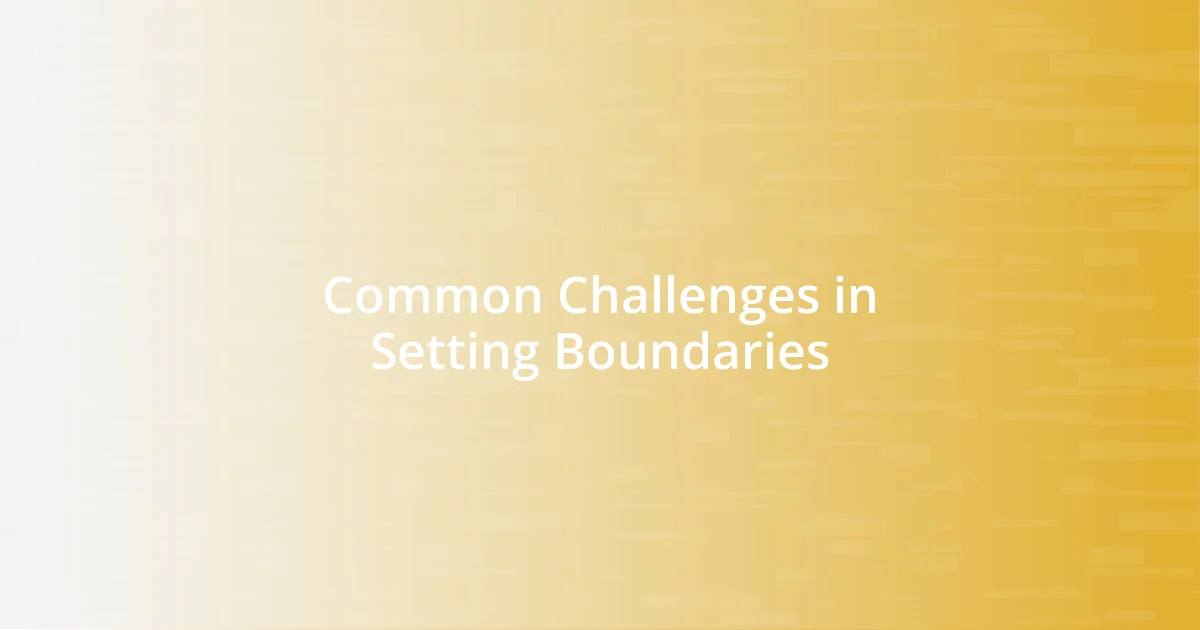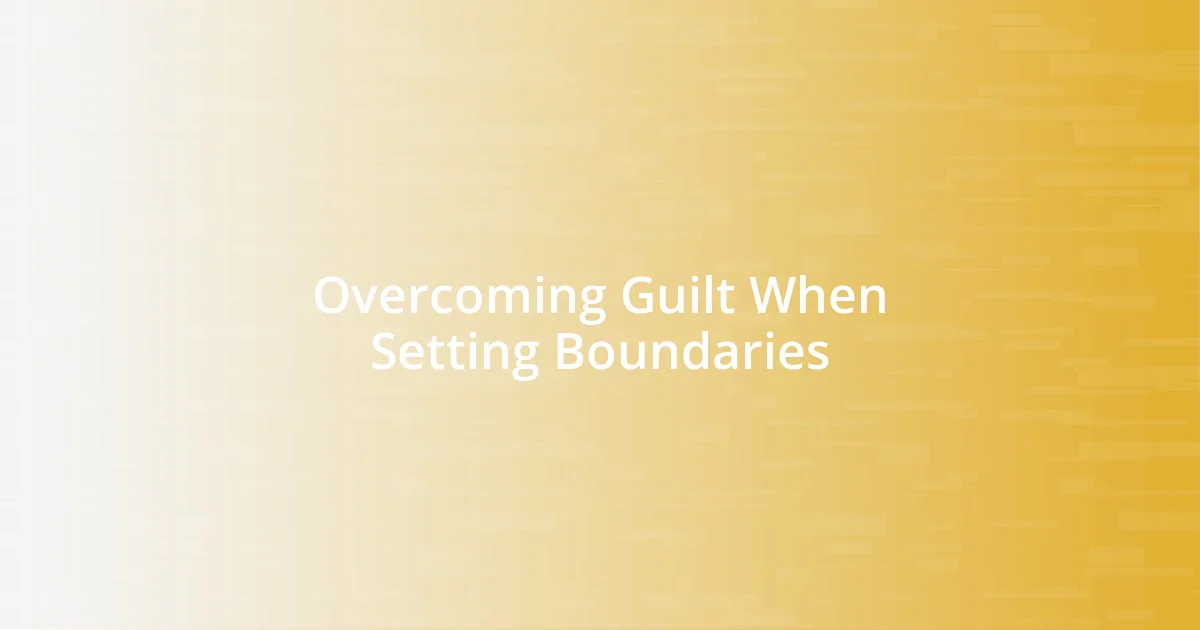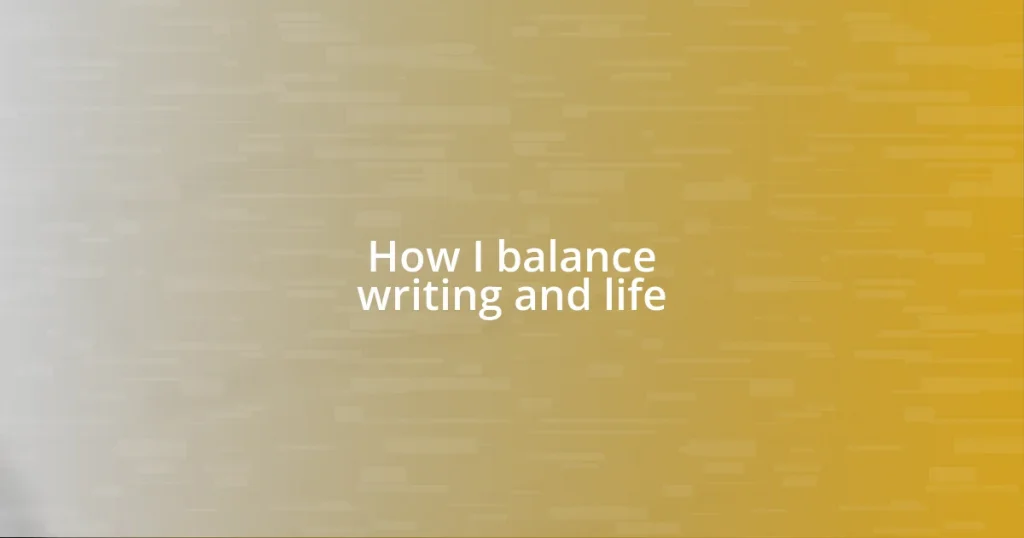Key takeaways:
- Establishing and maintaining boundaries is crucial for emotional well-being, helping to prevent burnout and improve relationships.
- Identifying personal boundaries involves self-reflection and understanding emotional triggers, enabling clearer communication of limits to others.
- Overcoming guilt in boundary-setting can be achieved by reframing boundaries as acts of self-care and sharing experiences with supportive peers.

Understanding the Importance of Boundaries
Boundaries are essential for our emotional well-being. I remember a time when I felt overwhelmed by constant demands from friends and family. It took me a while to realize that saying “no” was not only okay but necessary to protect my own mental space—can you relate to that feeling of being pulled in too many directions?
Setting boundaries helps clarify our needs and limits. When I first started establishing boundaries in my professional life, I faced resistance. But I learned that being clear about what I would and wouldn’t accept led to stronger, healthier relationships with my colleagues. Isn’t it fascinating how a simple limit can pave the way for mutual respect?
Moreover, boundaries prevent us from overextending ourselves and experiencing burnout. I’ve found that when I take time to recharge, it not only benefits me but allows me to show up better for others. Have you ever noticed how your own energy shifts when you prioritize your limits? Understanding the importance of these boundaries is truly a game changer.

Identifying Personal Boundaries
Identifying personal boundaries starts with self-reflection. I’ve often found that when I take the time to understand what truly makes me uncomfortable or stressed, I can better articulate my limits to others. For instance, during a particularly demanding season at work, I realized that constant interruptions were taking a toll on my productivity. Recognizing this allowed me to request specific hours for uninterrupted focus, which changed everything for my work-life balance.
Understanding my emotional triggers has also been essential in boundary setting. There was a period when I struggled with family gatherings. Identifying that certain conversations made me anxious helped me communicate my needs, leading to more enjoyable interactions. Have you noticed how awareness of your triggers can significantly influence your capacity to set boundaries?
To illustrate how boundaries manifest in different areas of life, consider the following comparison table.
| Boundary Type | Personal Insight |
|---|---|
| Emotional Boundaries | I’ve learned that protecting my feelings means being honest about what topics are off-limits. |
| Physical Boundaries | Establishing space in my relationships allows me to maintain my comfort levels, especially during gatherings. |
| Time Boundaries | Valuing my time by setting limits on commitments has significantly reduced my stress. |

Common Challenges in Setting Boundaries
Setting boundaries often feels like walking a tightrope. It’s challenging to assert oneself without fearing backlash or disappointing others. I remember a challenging moment when I decided to cut back on social commitments to prioritize my mental health. The guilt that washed over me was overwhelming, especially when friends expressed disappointment. Yet, I learned that I couldn’t pour from an empty cup. This experience highlights a common challenge: the fear of judgment or losing relationships can make boundary-setting daunting.
Here are several common challenges people face when setting boundaries:
- Fear of Rejection: There’s always a worry that setting boundaries might lead to being unloved or unwanted.
- Guilt: The feeling of letting others down can be paralyzing and often prevents us from articulating our needs.
- Cultural Expectations: Many cultures value selflessness, which can conflict with the act of self-advocacy.
- Inconsistency: I’ve noticed that sometimes, after successfully setting a boundary, I’d waver, leading to confusion about what I truly want.
- Lack of Confidence: Without knowing how to communicate boundaries effectively, I often stumbled through important conversations, unsure of my own needs.
These factors can complicate the journey toward healthier interactions. Recognizing them is the first step toward making boundary-setting feel more approachable.

Techniques for Communicating Boundaries
When it comes to communicating boundaries, choosing the right words is vital. I’ve learned that being direct yet kind often helps others understand where I stand. For example, instead of saying, “I can’t do this,” I often phrase it as, “I need to focus on my priorities right now, but I appreciate the offer.” This slight shift in language feels more respectful and helps mitigate any immediate negative reactions.
Non-verbal cues also play an essential role in boundary communication. I once attended a family gathering where, during a loud debate, I subtly used my body language to express discomfort. Crossing my arms and stepping back sent a clear message without saying a word. Have you ever noticed how your body can talk even when your mouth is silent? It’s incredible how such small gestures can reinforce your verbal messages, making your boundaries unmistakably clear.
Finally, follow-up conversations can solidify boundaries over time. After setting a new limit, I’ve found it helpful to check in with the people involved. I might say something like, “I appreciate your understanding these last few weeks while I adjusted my schedule. It’s really made a difference.” This continual dialogue not only strengthens the new boundary but also builds trust in relationships. How often do you revisit your boundaries? I believe it’s a crucial step to ensure mutual respect and understanding as situations evolve.

Strategies for Maintaining Boundaries
One effective strategy I’ve found for maintaining boundaries is setting regular check-ins with myself. I like to take a moment each week to reflect on how my boundaries are holding up. This practice not only helps me stay grounded but also allows me to notice when I might be slipping, like that time I said “yes” to an event that overwhelmed me. Have you ever felt that tightening around your chest when you realize you’ve overcommitted? It’s a gentle reminder that boundaries need tending.
Being consistent with my boundaries is another key strategy. I remember a situation where I initially set a limit on work hours, but a few late-night emails crept into my routine. Gradually, this eroded my boundary, leading to burnout. I learned the hard way that if I don’t uphold my own limits, others may interpret them as flexible. Have you experienced that tug-of-war between your commitments and your well-being? Staying resolute can be tough, but it reinforces that I value my time and energy.
Finally, sharing my boundaries with trusted friends or family has been immensely helpful. When I communicate my limits to those close to me, it creates accountability. For example, I confided to a friend about my need for solo time on weekends, which made it easier to say no to group plans without feeling guilty. How valuable do you think it is to have a support system in boundary-setting? With that encouragement, saying “no” becomes less daunting, and I feel more empowered to protect my space.

Overcoming Guilt When Setting Boundaries
I often find myself wrestling with guilt after setting a boundary. Just recently, I had to decline an invitation to a friend’s birthday party because I needed time to recharge. As I sent that text, a wave of guilt washed over me—was I being selfish? Looking back, I realized that prioritizing my mental health wasn’t an act of selfishness; it was a necessary step for my well-being. Have you ever felt torn between wanting to please others and taking care of yourself?
A technique that has helped me combat this guilt is reframing my thoughts. Instead of viewing my boundaries as restrictions, I now think of them as acts of self-care. For instance, I remind myself that each time I choose to say “no,” I’m creating space for activities or moments that truly matter to me. Whenever those guilt feelings arise, I ask myself, “Will this decision bring me joy or peace?” This simple shift in perspective makes a world of difference.
I’ve learned that sharing my experiences with others adds another layer of relief. There was a time when I felt guilty about missing family events, believing I should prioritize their needs above my own. By talking openly with supportive friends, I found that many of them faced similar struggles. They reassured me that it’s okay to focus on my priorities without neglecting those I care about. Discussing feelings helps dissipate the weight of guilt, doesn’t it? Realizing I’m not alone in this has empowered me to embrace my boundaries confidently.















